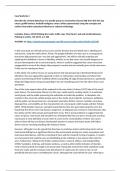Case Study No.1
Describe the criminal behaviour of a specific group or community (choose ONE from this list: boy
racers; graffiti writers; football hooligans; ravers; white supremacists) using the concepts and
notions from either subcultural theories or cultural criminology
Lumsden, Karen, (2013) Policing the roads: traffic cops, 'Boy Racers' and anti-social behaviour,
Policing & society, Vol.23 (2), p.1-100
Available at: https://ebookcentral.proquest.com/lib/surrey/reader.action?docID=1125248
In this Case study we will look at boy racers and the theories that are linked into it, labelling and
moral panic, using the article above. Firstly, the google definition of a boy racer is a young person
that drives high powered cars ‘very fast and aggressively’. We will be critically analysing and
exploring this definition in terms of labelling, whether or not boy racers are actually dangerous or
are just stereotyped to be so and moral panic, where it could be suggested boy racers have been
exaggerated in terms of the danger they propose to society and are instantly given a bad name even
if they are not causing any harm.
In this article, the author focuses on young drivers that had grouped up in the Beach Boulevard in
Aberdeen, this was supposedly organised so that car enthusiasts could socialise and share their
passion and showing off their modified vehicles and pulling off edgy driving manoeuvres, specifically
things like illegal street racing and speeding in the aim of getting praise from the other drivers and
spectators.
One of the main aspects that will be explored in this case study is Cohens (1972) idea of the moral
panic theory. The moral panic theory is in this case, media reports creating ‘devils’ of a particular
social group, and the public pressuring the authorities to tackle the problem. In Aberdeen, the
reaction to boy racers by outside groups such as the media, local residents, businesses, politicians,
and the police can be perceived as a moral panic (Lumsden 2012c). Concern, hostility, consensus,
disproportion, and volatility are five characteristics of a moral panic which Goode and Ben-Yehuda
(2009, 1994) identify. However, Lumsden found that the time she spent observing this event she
found that the drivers were not deviant, dangerous, or displayed any criminal or risky behaviour that
the media and the other groups portrayed them to do. This is strong evidence to suggest that boy
racers are given a bad name and shouldn’t be criminalised like they are due to moral panic and that
moral panic is most definitely a factor when it comes to the criminalisation of these ‘boy racers’
when to them all they are doing is sharing their passion in motors and motor sports with fellow
drivers and are not doing anything with malicious intent.
However, although it can be argued that they have no malicious intent, performing stunts such as
hand break drifting has a significant effect on the environment leaving tyre marks everywhere and
loud noise disturbances, with the screeching of tyres and the constant revving of engines, it creates
an environment that could be seen as intimidating to the residents or just anyone that visits the
area. Furthermore, linking to the broken window theory, James Q. Wilson, and George Kelling
(1982), Vandalism, loitering, and broken windows, as well as other visible indicators of disorder,
invite criminal activity and ought to be prosecuted. Having this environment with vandalised roads
from tyre marks and the constant noise disturbances it could cause for crime to rise. So not
specifically the boy racers committing the crimes, although that could still be the case, referring to




